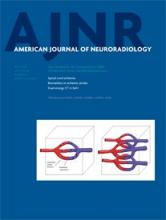Research ArticleNeurointervention
The Curved MCA: Influence of Vessel Anatomy on Recanalization Results of Mechanical Thrombectomy after Acute Ischemic Stroke
B.J. Schwaiger, A.S. Gersing, C. Zimmer and S. Prothmann
American Journal of Neuroradiology May 2015, 36 (5) 971-976; DOI: https://doi.org/10.3174/ajnr.A4222
B.J. Schwaiger
aFrom the Department of Diagnostic and Interventional Neuroradiology, Klinikum rechts der Isar der Technischen Universität München, Munich, Germany.
A.S. Gersing
aFrom the Department of Diagnostic and Interventional Neuroradiology, Klinikum rechts der Isar der Technischen Universität München, Munich, Germany.
C. Zimmer
aFrom the Department of Diagnostic and Interventional Neuroradiology, Klinikum rechts der Isar der Technischen Universität München, Munich, Germany.
S. Prothmann
aFrom the Department of Diagnostic and Interventional Neuroradiology, Klinikum rechts der Isar der Technischen Universität München, Munich, Germany.

REFERENCES
- 1.↵
- Seshadri S,
- Wolf PA
- 2.↵
- Mori E,
- Yoneda Y,
- Tabuchi M, et al
- 3.↵
- Saqqur M,
- Uchino K,
- Demchuk AM, et al
- 4.↵
- Smith WS,
- Lev MH,
- English JD, et al
- 5.↵
- Dávalos A,
- Pereira VM,
- Chapot R, et al
- 6.↵
- Nogueira RG,
- Lutsep HL,
- Gupta R, et al
- 7.↵
- Pereira VM,
- Gralla J,
- Davalos A, et al
- 8.↵
- Saver JL,
- Jahan R,
- Levy EI, et al
- 9.↵
- Yoon YH,
- Yoon W,
- Jung MY, et al
- 10.↵
- Zaidat OO,
- Castonguay AC,
- Gupta R, et al
- 11.↵
- Broussalis E,
- Trinka E,
- Hitzl W, et al
- 12.↵
- 13.↵
- Schwaiger BJ,
- Kober F,
- Gersing AS, et al
- 14.↵
- 15.↵
- Yuki I,
- Kan I,
- Vinters HV, et al
- 16.↵
- Gralla J,
- Burkhardt M,
- Schroth G, et al
- 17.↵
- 18.↵
- Behme D,
- Kowoll A,
- Weber W, et al
- 19.↵
- Zhu L,
- Liebeskind DS,
- Jahan R, et al
- 20.↵
- Diener HC,
- Weimar C
- Veltkamp R
- 21.↵
- 22.↵
- Parsons M,
- Spratt N,
- Bivard A, et al
- 23.↵
- 24.↵
- Berger C,
- Fiorelli M,
- Steiner T, et al
- 25.↵
- Youden WJ
- 26.↵
- Turk AS,
- Frei D,
- Fiorella D, et al
- 27.↵
- Kim SK,
- Yoon W,
- Moon SM, et al
- 28.↵
- Kang DH,
- Kim YW,
- Hwang YH, et al
- 29.↵
- Kass-Hout T,
- Kass-Hout O,
- Sun CH, et al
In this issue
American Journal of Neuroradiology
Vol. 36, Issue 5
1 May 2015
Advertisement
B.J. Schwaiger, A.S. Gersing, C. Zimmer, S. Prothmann
The Curved MCA: Influence of Vessel Anatomy on Recanalization Results of Mechanical Thrombectomy after Acute Ischemic Stroke
American Journal of Neuroradiology May 2015, 36 (5) 971-976; DOI: 10.3174/ajnr.A4222
0 Responses
Jump to section
Related Articles
- No related articles found.
Cited By...
- Early technique switch following failed passes during mechanical thrombectomy for ischemic stroke: should the approach change and when?
- Basilar tip morphology: impact on mechanical thrombectomy for acute distal basilar artery occlusion
- Bifurcation occlusions and endovascular treatment outcome in acute ischemic stroke
- In Vitro Analysis of the Efficacy of Endovascular Thrombectomy Techniques according to the Vascular Tortuosity Using 3D Printed Models
- Predictors and Impact of Sulcal SAH after Mechanical Thrombectomy in Patients with Isolated M2 Occlusion
- Mechanical thrombectomy beyond the circle of Willis: efficacy and safety of different techniques for M2 occlusions
- First-line contact aspiration versus first-line stent retriever for acute posterior circulation strokes: an updated meta-analysis
- Efficacy of beveled tip aspiration catheter in mechanical thrombectomy for acute ischemic stroke
- Neuroanatomy of the middle cerebral artery: implications for thrombectomy
- Direct thromboaspiration efficacy for mechanical thrombectomy is related to the angle of interaction between the aspiration catheter and the clot
- A systematic review and meta-analysis of observational evidence for the use of bailout self-expandable stents following failed anterior circulation stroke thrombectomy
- Stent retriever placement in embolectomy: the choice of the post-bifurcational trunk influences the first-pass reperfusion result in M1 occlusions
- Balloon-assisted tracking technique to overcome intracranial stenosis during thrombectomy for stroke
- First-in-man experience of the Versi Retriever in acute ischemic stroke
- Stent retrievers with segmented design improve the efficacy of thrombectomy in tortuous vessels
- Intraprocedural predictors of post-stent retriever thrombectomy subarachnoid hemorrhage in middle cerebral artery stroke
- Balloon-assisted tracking technique to overcome intracranial stenosis during thrombectomy for stroke
- Middle cerebral artery geometric features are associated with plaque distribution and stroke
- Thrombectomy using the EmboTrap device: core laboratory-assessed results in 201 consecutive patients in a real-world setting
- Reasons for Reperfusion Failures in Stent-Retriever-Based Thrombectomy: Registry Analysis and Proposal of a Classification System
- What to do about fibrin rich 'tough clots? Comparing the Solitaire stent retriever with a novel geometric clot extractor in an in vitro stroke model
- TREVO and Capture LP have equal technical success rates in mechanical thrombectomy of proximal and distal anterior circulation occlusions
- Emergent mechanical thrombectomy for acute stroke using the Mindframe Capture LP system: initial single-center experience
This article has not yet been cited by articles in journals that are participating in Crossref Cited-by Linking.
More in this TOC Section
Similar Articles
Advertisement











